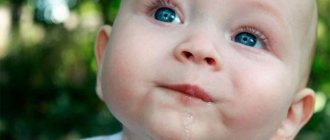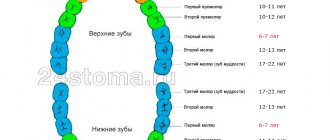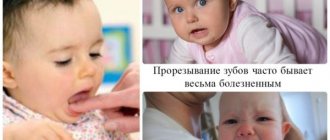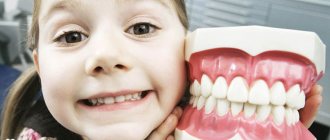Knowing the symptoms of teething and being able to provide assistance, loving parents will alleviate the baby’s condition and protect him from unpleasant complications. Often, teeth appear according to individual timing. Parents don't need to worry. A deviation from the norm of 1-2 months is not a pathology. If the schedule changes significantly, the help of a doctor is necessary. The examination begins with a pediatrician and dentist.
Signs that teeth are being cut
Many young parents do not immediately understand the reason for this child’s behavior and come up with terrible diagnoses before the doctor explains to them what the problem really is. But how not to confuse teething with illness or discomfort of the baby? At what age does the first tooth begin to cut? What to do to ease the baby's suffering? All this will be discussed below. Before the first teeth erupt, the baby feels discomfort, so he constantly tries to massage the gums with “improvised objects”
All babies experience the eruption of their first teeth differently: some go through this period steadily and relatively painlessly, while others suffer and suffer. It is difficult to explain what this difference depends on, but we can say with certainty that not a single newborn has had an absolutely comfortable teething process.
How can parents determine that their baby has started teething? There are several symptoms that are most common.
- The baby's salivation increases, he begins to move his jaws more often, as if he is trying to chew something or massage his gums.
- The child becomes more excitable, he may cry more often for no reason, be capricious, sleep poorly, and sometimes refuse to eat.
- An increase in body temperature also indicates the appearance of the first teeth.
- The baby may have diarrhea.
- The gums become swollen and red, and itching appears. If such symptoms are present, the baby more often touches his mouth with his hands, tries to stick his fingers into it, and rubs his cheeks.
- Teething is often accompanied by a weakened immune system. Against this background, the baby may develop a cough or runny nose.
The formation of teeth in humans begins several months before birth. For example, baby teeth are formed in a baby in the fourth month of the mother’s pregnancy, and then (the fifth and sixth months) the molars are formed.
Scheme of baby teeth eruption
To make it easier for parents to navigate the teething system, they can print out a reminder for themselves with a picture of the jaws, an indication of the teeth, and a description of exactly when certain dental units are cut.
This is how a child’s teeth erupt according to the following pattern:
- 6-10 months - central incisor, lower jaw;
- 8-12 months - central incisor, upper jaw;
- 9-13 months - lateral incisors, upper jaw;
- 10-16 months - lateral incisors, lower jaw;
- 13-19 months - molar, upper jaw;
- 14-18 months - molar, lower jaw;
- 16-22 months - canines, upper jaw;
- 17-23 months - canines, lower jaw;
- 23-31 months - second molar, lower jaw;
- 21-31 months - second molar, upper jaw.
It turns out that at the age of two, the second molars of both jaws usually emerge. But it is difficult to say whether this is the most difficult teething for the baby. It is believed that fangs are more painful, which is due to their sharp edges. They literally tear the gums apart. The canines of the upper jaw are perhaps the most painful in their eruption. They are also called ophthalmic because they are connected to the facial nerve.
Table. Features of the eruption of baby teeth
| Category for evaluation | Description | Process Features |
| Age | Baby teeth erupt from six months to three years; if something doesn’t go according to plan, be sure to go to the doctor. | The average eruption rate may be shifted for some time |
| Duration | 2-7 days is the norm for the eruption of one tooth | It happens that this period is prolonged: if it lasts more than two weeks, consult a doctor |
| First tooth | Usually it takes longer to climb than others, i.e. more than a week | Depends on the individual characteristics of the body |
Many parents think that the first teeth are the most painful to cut, and the eruption of molars in two-year-old children is not accompanied by such pain. Therefore, parents may not understand what causes the capricious behavior of a two-year-old child, or what worries him.
Period of eruption of permanent teeth -
The eruption of permanent teeth has a number of features, because... This process occurs simultaneously with the resorption of roots and loss of baby teeth. The rudiments of permanent teeth are located only 1-2 mm from the roots of milk teeth, and when a permanent tooth begins to erupt, it puts pressure on the roots of the milk tooth located above it, which leads to their resorption. Accordingly, baby teeth gradually lose contact with bone tissue, and their crowns become mobile.
And only the eruption of molars (large lateral chewing teeth) occurs without the loss of milk teeth, which is associated with a smaller number of the latter. By the way, in girls, the loss of baby teeth, as well as the beginning of the eruption of permanent teeth, occurs 4-7 months earlier than in boys, which is associated with hormonal levels. You can see the sequence and timing of the eruption of permanent teeth in children in diagram No. 2, which clearly shows the time ranges for the start of eruption for each permanent tooth.
Eruption of second molars
The first fundamental units of the primary occlusion are the molars. They have the largest chewing area. They are diamond-shaped from above and cube-shaped from below. Children have 8 molars - two on each side below and above. The first molar and the second molar are distinguished. In terms of ranking from the central incisors, they occupy 4th and 5th positions. Their cutting order is as follows:
- the first in the lower jaw – 13-18 months;
- the first in the upper jaw – 14-19 months;
- the latter in the lower and upper jaws erupt approximately equally - at 23-31 months.
After a year, parents should prepare to meet these “guests”: the first to climb will be the one in the top row. By the age of two, the second ones appear. The correct sequence of appearance ensures a beautiful and correct bite. Many parents like to look into their babies' mouths and check how their teeth are coming in. You shouldn’t do this and worry the baby once again. Genetics plays a large role in this process.
There is no need to interfere: nature will take care of everything itself. A photo of molars will help you find out what chewing units look like. To help the child and alleviate his condition, it is very important for parents to know what the symptoms of teething are. Since the process occurs after a year, many children can already point to the sore spot and even say what they feel.
How to help your baby?
The only troubles that can be explained by the appearance of teeth are mild “crankiness”, drooling and the formation of bad habits, for example, finger sucking. Appetite may decrease, the rhythm of sleep and wakefulness may be disrupted due to constant itching of the gums. Of course, these manifestations do not bother the baby for 2 years without stopping; as a rule, there are days when the child shows the greatest concern about teething. How can you make life easier for a child during this difficult period?
- Remedy No. 1
. Double the affection and care of parents. Don't be afraid to spoil your baby; Constant crying and whims spoil your character much more! - Remedy No. 2
. Using teethers. These are rubber or plastic toys that your baby can bite on. Chewing teething rings with liquid inside, which can be placed in the refrigerator and cooled, is especially soothing. A child aged 6 months and older will feel better even after chewing on a clean, cold cloth. - Remedy No. 3
. Gently massage the gums with a gauze pad. Wrap your index finger in a gauze pad soaked in cold water and gently massage your baby's gums. - Remedy No. 4
. A homeopathic medicine that must be prescribed by a pediatrician or homeopathic physician. - Remedy No. 5
. Medicinal. Pain-relieving gels containing a local anesthetic, such as lidocaine (available in pharmacies without a prescription). They cause numbness in the gums and thereby relieve pain.
Many mothers believe that while the child has few teeth and they are baby teeth, it is not necessary to brush them. However, this is not true at all! In young children, the protective properties of tooth enamel are reduced and in the presence of provoking factors (consumption of sugar-containing products, poor oral hygiene), this can lead to the development of caries.
If your child has a fever
A temperature of 37 degrees is considered normal; up to 37.5 this will also not be considered a special or complicated situation. Children usually feel fine with such a slight increase in temperature. Naturally, there is no point in giving an antipyretic in this case.
If the temperature rises above 38 degrees, it is worth saying that inflammation or infection has joined the teething process. This situation requires seeing a doctor (he needs to be called to your home), and only his recommendations will be your tactics in future behavior.
During this period, children experience pain, malaise, and weakness that were not typical before, so their behavior changes, sleep disturbances and refusal to eat are noted, which only aggravates the temperature reaction. First of all, the child needs rest, calm and healthy sleep, because temperature, on the one hand, is a protective reaction, and on the other, a debilitating process, which, if unfavorable, can cause overstrain of all organs and systems with the development of pathological reactions: weakness, drowsiness, tachycardia and even febrile seizures.
And remember that the antipyretic should be strictly for children, ideally recommended by a doctor. These are usually paracetamol-based drugs. If they do not help, you can give the child Ibuprofen (but it is prescribed to children from one year old).
But under no circumstances should children be given medications of the aspirin and analgin group. These are toxic drugs that cause side effects.
An excellent tactic for high temperatures would be to humidify the air in the room, regularly ventilate (while the child is in another room), drink plenty of fluids and eat as desired. The child should drink a lot of warm drinks and eat only when he wants to. Avoid dry air, wrapping yourself up in three pajamas and two blankets. If a child wants to play at a high temperature, there is no need to force him to go to bed.
It is important to understand that if the temperature is elevated for more than three days, it is unlikely that the problem is teething. And when it still doesn’t go astray, urgently call a doctor and look for the real reason for this reaction of the body.
Teething is not a very long period. By the age of three, it is definitely completed, and then you will already wait for the loss of milk teeth and the growth of permanent ones. As a rule, the child tolerates these processes normally. To make sure everything is in order, visit your pediatric dentist every six months. You can take care of baby teeth from the moment they appear. Teach your child to brush his teeth twice a day, monitor the quality of brushing.
Parents helping their child when his molars are being cut
The process of erupting molars is long and painful. During these periods, parents should try to be very attentive and tolerant towards their baby. To reduce pain and anxiety, pediatric dentists recommend using special gels that are cooled in teethers.
If your temperature rises or alarming symptoms such as runny nose or cough appear, you should definitely consult a pediatrician. The doctor will determine the exact cause and may prescribe anti-inflammatory drugs.
Teething is a period when increased attention to oral hygiene is required. For this age, you need to choose the right toothpaste for your child. For example, children's toothpaste from the ASEPTA baby series for children aged 0 to 3 years significantly reduces the number of harmful microbes in the child's mouth, so that the difficult period of teething passes without unnecessary hassle.
Help from folk remedies
If you do not want to give your baby medications, you can use natural formulations. In this case, it is necessary to take into account the possibility of an allergic reaction in the baby. Also follow safety precautions and remember that small objects can be swallowed or choked by the baby.
- Amber beads
. These products are made from Baltic products. They have a pronounced analgesic and regenerating effect. In addition, the product can relieve fever and fever. The beads are made in such a way that they can enhance the effect of other medications. - Plant herbs
. Herbs such as chamomile and phytolacca can help alleviate the teething condition of a child. They relieve inflammation and partially relieve gum pain. Remember that they must be used in accordance with the instructions. You should not give your baby prepared formulas to drink. Simply treat the inflamed areas of the mucous membrane with the decoction.
Teething disorders - symptoms and treatment
In case of teething problems, symptomatic treatment is carried out. Its purpose is to eliminate pericoronitis, oral abscess and osteomyelitis.
Treatment of pericoronitis
Treatment of pericoronitis is carried out on an outpatient basis. If the tooth germ is positioned correctly and there is enough space for the dental arch, then surgical treatment is the most preferable option. The mucous membrane in the area of the tooth crown is completely excised. As a result, access to the chewing and lateral surfaces of the crown appears. The operation is performed under anesthesia and can be performed either with scissors or a scalpel, or with more modern methods: cryodestruction, laser and electric knife.
pericoronarotomy can be performed - an operation during which the mucous membrane above the tooth crown is dissected. As a result, tooth surfaces that were previously covered by a hood of mucous membrane are exposed.
After surgical treatment, drug therapy :
- Antibacterial agents are selected individually, taking into account the microflora. It can be:
- Inhibitor-protected penicillins that destroy anaerobic and aerobic microorganisms. Amoxicillin with clavulanic acid is most effective.
- Lincomycin and Clindamycin act against Staphylococcus aureus.
- Metronidazole is not effective against facultative anaerobes and aerobes, but together with other antibiotics it will help cope with mixed microflora.
- Cephalosporins act only together with Metronidazole and Clindamycin, since almost all anaerobic microorganisms are insensitive to them.
- The latest generations of fluoroquinolones are effective against gram-positive bacteria, but each drug has its own level of activity.
- Non-steroidal anti-inflammatory drugs.
- Antihistamines [10].
- Detoxification therapy consists of drinking plenty of warm drinks rich in vitamins, such as compotes and fruit drinks. Sometimes in difficult situations, an isotonic solution is administered intravenously.
To alleviate local symptoms and reduce inflammation, baths with antiseptic solutions are used: a pale pink solution of potassium permanganate, 0.01% Miramistin solution or 0.05% Chlorhexidine.
Treatment of oral abscess
Treatment for an oral abscess includes surgery and medication. Depending on the location of the abscess and the general condition of the patient, it can be performed in a clinic or in a hospital. During the operation, the purulent-inflammatory focus is opened, the postoperative wound is treated with antiseptics and drained.
After surgery, medications must be prescribed. They are similar to those used to treat pericoronitis. To detoxify, it is recommended to drink plenty of alkaline liquids, such as mineral water and cranberry juice.
For several days after the operation, the wound is bandaged daily and treated with antiseptics.
Treatment of osteomyelitis
If osteomyelitis is detected, the patient is immediately hospitalized. The erupting tooth is removed, and all purulent foci are carefully treated. Antibacterial drugs are administered intravenously. For detoxification, saline solutions are used, which are also administered intravenously.











